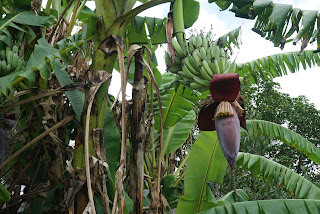 |
| (From Wikipedia) |
Things have changed. The stink of flenshing no longer lingers, drinking places offer cocktails not grog. On prostitution I have no information. Like many a reformed rake, Russell is now squeakily genteel. I'm told that Pahia, across the bay, is wilder. It has, perhaps, traffic lights so you can jaywalk.
But imagine you are walking along Russell's main street. "The sun pours down like honey" seems a particulary apposite quote. To your right beyond the row of gleaming white buildings is a pedestrian track, beyond that a gravelly beach and the ocean. On your left a row of mostly "useful" shops: hardware, pharmacy, estate agent, wine shop, 4 Square (like Spar), a bakery that closes when it's sold all its bread (about 11.30am), the Internet Cafe (on its last legs - it also sells locally made frozen meals for one), a charity shop and a second hand book shop (where we bought an Angela Carter and John Fowles worst reviewed novel). At the end of the quarter mile that is Russell stands NZ's oldest Anglican church with Russell Museum opposite. That row is enough to service the 800 or so permanent residents of the village.
The pedestrian esplanade is lined with eating and coffee places, dress and memorabilia shops but there are also residential houses, the town hall and one of the most elegant police houses in the world.
At lunch today we had a stunning view across a bay dotted with small boats and islands. This part of town hasn't changed more than you'd expect.
For the big change, look inland. After a few non-descript streets the land rises sharply upwards on three sides. What were wooded slopes are now festooned with very large, very modern, very expensive villas - most of them holiday homes of the rich.
A population of 800 becomes about 6000 in the summer - with a consequent increase in prices, especially for property. Building houses on the hill sides means views over the harbour but also many more sealed tracks up to houses (increasing the speed of rain run off), many more big cars and so on. This view was almost virgin bush when we last visited.
But sitting here by our van, it still looks good.
But imagine you are walking along Russell's main street. "The sun pours down like honey" seems a particulary apposite quote. To your right beyond the row of gleaming white buildings is a pedestrian track, beyond that a gravelly beach and the ocean. On your left a row of mostly "useful" shops: hardware, pharmacy, estate agent, wine shop, 4 Square (like Spar), a bakery that closes when it's sold all its bread (about 11.30am), the Internet Cafe (on its last legs - it also sells locally made frozen meals for one), a charity shop and a second hand book shop (where we bought an Angela Carter and John Fowles worst reviewed novel). At the end of the quarter mile that is Russell stands NZ's oldest Anglican church with Russell Museum opposite. That row is enough to service the 800 or so permanent residents of the village.
 |
| Russell Church - From about 1850 Maori and European gravesare side by side and both languages are used. |
 |
| Police House |
For the big change, look inland. After a few non-descript streets the land rises sharply upwards on three sides. What were wooded slopes are now festooned with very large, very modern, very expensive villas - most of them holiday homes of the rich.
A population of 800 becomes about 6000 in the summer - with a consequent increase in prices, especially for property. Building houses on the hill sides means views over the harbour but also many more sealed tracks up to houses (increasing the speed of rain run off), many more big cars and so on. This view was almost virgin bush when we last visited.
But sitting here by our van, it still looks good.















